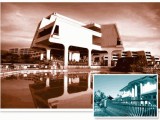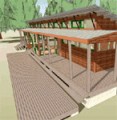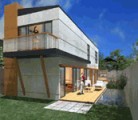|
March 31, 2004 < Prev PostPermalinkNext Post > Let's face it folks - taken as a whole, Hawaii architecture sucks. And the urban planning leaves a lot to be desired. While the islands have seen a few distinctive architects that were compelled, nurtured, and influenced by Hawaii's natural environment - Dickey, Ossipoff, Morgan - the last 40 years has been witness to a slow decline of the man-made environment. Can you name one local architect, much less visually describe their works? Internally, your living environment affects how you think, how you plan and conduct your daily life, and how you act towards others. Externally, the look, mood, and design of living environments affects geographic desirability, how society and government is viewed, and a myriad of economic issues. If you live in a concrete box, you will think like a concrete box. The Honolulu Weekly featured a particularly nasty McMansion recently. Some local architects, such as Patrick Tozier, have rallied against local mediocrity (September 2003): Hawaii Kai is one of the most garish neighborhoods I've seen. Hawaii is not Greece, Italy, or Hollywood. So why build faux (stucco, fenced-in, highly paved) structures which are neither here nor there? Hawaii is made of islands, standalone communities that must work together. So where's the mixed-use zones and the co-housing developments that strengthen community and small businesses while reducing waste? Where's the open, flowing, natural, "outdoors is in" architecture that complements Hawaii's culture and environment? Why do new developments persist in creating isolated pockets of (condo, suburban) living, entertainment, and business? This type of forward-thinking architecture is not more expensive, contrary to the typical developer's worldview. It only requires more creativity. Witness the works of architect John Lautner (the most successful of Frank Lloyd Wright's students), who built the Science Building at UH Hilo. It had a natural ventilation system that all but eliminated air conditioning costs. A civic administration building of his was made of formed concrete which included inspiring views and natural integration with the outside. It was a joy to work in, met all of the county requirements, and ended up costing less than traditional plans. People are paying more attention to their homes, community, and design these days, as evidenced by real estate booms in California and Hawaii and nesting trends of older generations. Here's an enjoyable design site that offers new ideas daily in architecture and industrial design: "Modern contemporary design and architecture" Magazines about homes - called "shelter magazines" - are taking off despite an overall decrease in magazine sales, with 40 launched in 2002 alone: In the Bay Area, multiple offers over 10 are not uncommon. Houses have gone for $300,000 over the asking price. Median home prices in San Francisco are $200,000 over that of Oahu and $100,000 over that of Maui. The average Bay Area home is $100,000 more than the average home on Oahu: The last two years have seen a rise in co-housing and prefabricated architecture projects in Europe and the U.S.. Thanks to the support of cutting-edge shelter magazines such as Dwell (http://www.dwellmag.com/) and new building technologies, a slew of cheap, beautiful, sturdy, and highly customizable prefab housing designs are being created - even ones that are made for urban settings. The Dwell House - Modern Modular These projects are perfect for Hawaii - they are low-cost, replaceable, expandible/evolveable, tough, and designed beautifully with a sense of environment. A number of them incorporate environmentally-conscious building materials and methods. "Urban change requires vision" "Building modernism on a pre-fab budget" Hawaii construction and typical apartment developments use a lot of concrete, a material that John Lautner considered "most desireable" for his needs. But these developments often end up being blocky and oppressive, instead of the light, flowing, organic constructions that Lautner made. If local architects aren't willing to follow that cue, at least here's a translucent concrete material that can make buildings appear light and airy instead: Looking at the other side of the world, here's an overview of China's recent massive architectural works: "...the building boom sweeping over China has no precedent in human history." They're using over 54% of the world's concrete, 36% of the world's steel, and 30% of the world's coal: |


